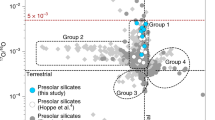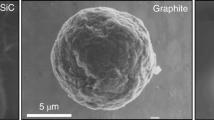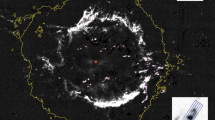Abstract
Sulphur is depleted in cold dense molecular clouds with embedded young stellar objects1, indicating that most of it probably resides in solid grains. Iron sulphide grains are the main sulphur species in cometary dust particles2,3, but there has been no direct evidence for FeS in astronomical sources4, which poses a considerable problem, because sulphur is a cosmically abundant element. Here we report laboratory infrared spectra of FeS grains from primitive meteorites, as well as from pyrrhotite ([Fe, Ni]1-xS) grains in interplanetary dust, which show a broad FeS feature centred at ∼23.5 micrometres. A similar broad feature is seen in the infrared spectra of young stellar objects, implying that FeS grains are an important but previously unrecognized component of circumstellar dust. The feature had previously been attributed to FeO5,6,7. The observed astronomical line strengths are generally consistent with the depletion of sulphur from the gas phase1, and with the average Galactic sulphur/silicon abundance ratio8. We conclude that the missing sulphur has been found.
This is a preview of subscription content, access via your institution
Access options
Subscribe to this journal
Receive 51 print issues and online access
$199.00 per year
only $3.90 per issue
Buy this article
- Purchase on Springer Link
- Instant access to full article PDF
Prices may be subject to local taxes which are calculated during checkout



Similar content being viewed by others
References
Joseph, C. L., Snow, T. E., Seab, C. G. & Crutcher, R. M. Interstellar abundances in dense, moderately reddened lines of sight. I. Observational evidence for density-dependent depletion. Astrophys. J. 309, 771–782 (1986)
Schulze, H., Kissel, J. & Jessberger, E. K. in Stardust to Planetesimals (eds Pendleton, T. L. & Tielens, A. G. G. M.) Astron. Soc. Pacific. Conf. Ser. 122, 397–414 (1997)
Dai, Z. R. & Bradley, J. P. Iron-nickel sulfides in anhydrous interplanetary dust particles. Geochim. Cosmochim. Acta 65, 3601–3612 (2001)
Palumbo, M. E., Geballe, T. R. & Tielens, A. G. G. M. Solid carbonyl sulfide (OCS) in dense molecular clouds. Astrophys. J. 479, 839–844 (1997)
Meeus, G. et al. ISO spectroscopy of circumstellar dust in 14 Herbig Ae/Be systems: Towards an understanding of dust processing. Astron. Astrophys. 365, 476–490 (2001)
Waters, L. B. F. M., Molster, F. J. & Waelkens, C. in Solid Interstellar Matter: The ISO Revolution (eds D'Hendecourt, L., Joblin, C & Jones, A.) 219–229 (Springer, Berlin, 1998)
Henning, T., Begemann, B., Mutschke, H. & Dorschner, J. Optical properties of oxide dust grains. Astron. Astrophys. Suppl. 112, 143–149 (1995)
Anders, E. & Grevesse, N. Abundances of the elements—Meteoritic and solar. Geochim. Cosmochim. Acta 53, 197–214 (1988)
Kessler, M. F. et al. The Infrared Space Observatory (ISO) mission. Astron. Astrophys. 315, L27–L31 (1996)
Bouwman, J., de Koter, A., van den Ancker, M. E. & Waters, L. B. F. M. The composition of the circumstellar dust around the Herbig Ae stars AB Aur and HD 163296. Astron. Astrophys. 360, 213–226 (2000)
van den Ancker, M. E. et al. ISO Spectroscopy of circumstellar dust in the Herbig Ae systems AB Aur and HD 163296. Astron. Astrophys. 357, 325–329 (2000)
Lodders, K. & Fegley, B. in Asymptotic Giant Branch Stars (eds LeBertre, T., Lebre, A. & Waelkens, C.) 279–293 (IAU Symposium 191, 1999)
Begemann, B. et al. A laboratory approach to the interstellar sulfide dust problem. Astrophys. J. 423, L71–L74 (1994)
Nuth, J. A. et al. Laboratory infrared spectra of predicted condensates in carbon-rich stars. Astrophys. J. 290, L41–L43 (1985)
Lennie, A. R. & Vaughan, D. J. Kinetics of the marcasite-pyrite transformation: An infrared spectroscopic study. Am. Mineral. 77, 1166–1177 (1992)
Hofmeister, A. M., Rosen, L. J. & Speck, A. K. in Thermal Emission Spectroscopy and Analysis of Dust, Disks, and Regoliths (eds Sitko, M. L., Sprague, A. L. & Lynch, D. K.) Astron. Soc. Pacif. Conf. Ser. 196, 291–300 (2000)
Malfait, K. et al. The spectrum of young star HD 100546 observed with the Infrared Space Observatory. Astron. Astrophys. 332, L25–L28 (1998)
Crovisier, J. et al. The spectrum of comet Hale-Bopp (C/1995 O1) observed with the Infrared Space Observatory at 2.9 astronomical units from the Sun. Science 275, 1904–1907 (1997)
Mutschke, H. et al. Steps toward interstellar silicate mineralogy. III. The role of aluminum in circumstellar amorphous silicates. Astron. Astrophys. 333, 188–199 (1998)
Draine, B. T. & Lee, H. M. Optical properties of interstellar graphite and silicate grains. Astrophys. J. 285, 89–108 (1984)
Savage, B. D. & Sembach, K. R. Interstellar abundances from absorption-line observations with the Hubble Space Telescope. Annu. Rev. Astron. Astrophys. 34, 279–330 (1996)
Christoffersen, R., Keller, L. P. & McKay, D. S. Microstructure, chemistry, and origin of grain rims on ilmenite from the lunar soil finest fraction. Meteorit. Planet. Sci. 31, 835–848 (1996)
Bradley, J. P. Chemically anomalous preaccretionally irradiated grains in interplanetary dust from comets. Science 265, 925–929 (1994)
Keller, L. P., Messenger, S. & Bradley, J. P. Analysis of a deuterium-rich interplanetary dust particle and implications for presolar materials in IDPs. J. Geophys. Res. A 105, 10397–10402 (2000)
Keller, L. P., Messenger, S., Miller, M. A. & Thomas, K. L. Nitrogen speciation in a 15N-enriched interplanetary dust particle. Lunar Planet. Sci. 28, 1811–1812 (1997)
Acknowledgements
We thank L. Miller, L. Carr and G. Williams at the National Synchrotron Light Source at Brookhaven National Laboratory for technical assistance. Much of this work was performed while L.P.K. was a Senior Research Scientist at MVA, Inc. F.J.M. acknowledges support from an NWO Talent Grant. L.B.F.M.W., S.H., A.d.K. and J.B. acknowledge financial support from an NWO Pioneer Grant. We thank A. Li and D. Wooden for comments on the manuscript. This work was supported in part by NASA and ESA.
Author information
Authors and Affiliations
Corresponding author
Ethics declarations
Competing interests
The authors declare that they have no competing financial interests.
Rights and permissions
About this article
Cite this article
Keller, L., Hony, S., Bradley, J. et al. Identification of iron sulphide grains in protoplanetary disks. Nature 417, 148–150 (2002). https://doi.org/10.1038/417148a
Received:
Accepted:
Issue Date:
DOI: https://doi.org/10.1038/417148a
This article is cited by
-
Iron whiskers on asteroid Itokawa indicate sulfide destruction by space weathering
Nature Communications (2020)
-
Nanoscale infrared spectroscopy as a non-destructive probe of extraterrestrial samples
Nature Communications (2014)
Comments
By submitting a comment you agree to abide by our Terms and Community Guidelines. If you find something abusive or that does not comply with our terms or guidelines please flag it as inappropriate.



